Campache, México.
Travel & Tour
Pictures, Photos, Images, & Reviews.
George & Eve DeLange
Google Map To The Balamkú Archaeological Ruins.
Campache, Rio Bec Region, Mexico.
We Are Proud Of Our SafeSurf Rating!
View Larger Map
Click On Any Of The Following Links By Amazon.Com
For Books Or Videos About Touring The Yucatán Peninsula In Mexico. No Obligation!

"The Earth Monster."
 |
| "The Earth Monster." |
|---|
Balamkú, Campeche, a Mayan ruin located 3 km Northeast off of highway 186 halfway between Xpuhil and Escarcega. Balamkú, in Mayan means "Jaguar's Temple" (balam- jaguar, ku- temple). Balamku was discovered by chance in November of 1990 by Florentino García Cruz, an archaeologist for the Campeche Regional Center of INAH. The local people call the site Chunhabil. Balamkú has carvings that are remarkable in their detail. Consisting of three large stucco friezes of a rabbit, an alligator and a jaguar, the major reliefs are then flanked by many other small animal carvings. The main attraction of this early pre-Classic site is to see the building called; the Structure Of The "House Of The Four Kings". In the "House Of The Four Kings" lies the before mentioned frieze made of polychrome molded stucco, unique in the Mayan area, which was built between the years 550 and 650 A. D. The frieze represents the surface of the Earth formed by several images such as jaguars that symbolize war, aquatic elements that represent fertility and masks of the Monster of the Earth (Cauac), separating the underworld (kingdom of the dead), from the upperworld (kingdom of the gods). From this surface aquatic animals emerge (2 toads and 2 crocodiles) with their mouth opened into 180°, which represent the Earth in its vegetative and fertile feature. The kings of the upperworld are responsible for the abundance and wealth of its subjects. When we enter the edifice through its three doors that are located under the frieze, our entrance symbolizes the entrance to the Mayan underworld. The following is quoted from an INAH Sign at Balamku. "Besides illustrating the opposite and complementary aspects of the underworld, Balamkú's frieze compares dynastic and solar cycles. The king raises from the earth monster's maw, just as the Sun emerges from the Earth's mouth. The ruler's death is seen as if it were a sunset, when he falls into the monster's mouth. A double emanation is illustrated: an amphibian arises from the earth monster's cleft, and from its mouth the king emerges. The large masks and jaguars express the wealth of the earth, and the amphibian assures transition between these two worlds. Simultaneously this motif signifies glorification of the kingdom and the demonstration of its earthly origin and its nexus to fertility. The frieze indicates the nature and function of the building where it belongs: the upper level corresponds to the earth's surface, and the substructure is the underworld. Therefore, when someone enters through one of the building's doors, it is as if they were penetrating the underworld." Balamku, Calakmul, Chicanna and Xpuhil are so close together that they can be visited in one day if necessary. If you visit Balamku you will notice that the frieze is so very large and that the room it is enclosed in is so very small and dark that the frieze is difficult to photograph. Also no flash photography is permitted. We suggest the use of a wide angle lens and if using film you need to use 800+ ASA film. We suggest having a photo lab to develop the film and to push it one stop. If using a digital camera, set your camera for low light with wide apature exposure. Try to set your camera speed for less than a half second. Our photos were with wide angle at low light conditions on a digital camera. Unfortunately our low light focus was not working and some came out a little out of focus. Our photos were taken on February 2, 2004 at about 1 PM. A word about the Río Bec Region. The words Río Bec refer to a style of the temple pyramids which are located in the central Maya lowlands. The temple-pyramids are characterized by a unique architectural style that began to appear during the seventh century A.D. and continued into the early twelfth century A.D. The temple - pyramids usually have what is called a range-type of building with a similar looking, nonfunctional tower; on each of the opposit ends of the range-type building. As the height of the twin towers increases, the twin towers narrow; giving the illusion of being greater in height than they actually are. In addition, the twin-towers appear to have stairs along their faces leading to the temple that rests atop them. However, the steps are only a design motif that creates the illusion of functional stairs. The temples, which appear to be located on the singular platform at the top each of the Río Bec towers are solid masses of design stone, with no interior rooms, so they are inoperative as well. Also, there are Pseudo-doorways, built into niches, located at the fronts of the temples, giving the temple the appearance of having a functional door. The purpose of the Río Bec temple-pyramids is unknown at this time. But, they are pretty! Many of the structures are unmarked so we have no captions under most structure photos on this page.
|
The Ing. Alberto Acuña Ongay International Airport (IATA: CPE, ICAO: MMCP), also known as Campeche International Airport, is the international airport located in Campeche, Campeche, Mexico. It handles the national and international air traffic of the city of Campeche. It's operated by Aeropuertos y Servicios Auxiliares, a federal government-owned corporation. There are several good hotels or motels in the Campeche area, and if you need a place to stay; Priceline.com can arrange that for you. In fact, we think they are the best way to do it! We also have links on this page, that will connect you directly with several of the best hotels in in the Campeche area. Hotels that we have personally used! We suggest getting a hotel, and then letting them arrange for either a car, or a tour of the Campeche area and/or the Río Bec Region. If you call their Concierge Services, ahead of your arrival, all of this can be pre-arranged for you. We have used this method, many times, when traveling in Mexico. We have found it to be safe and it works!!! We have never experienced a problem, doing it this way! Our first choice for exploring this region (only due to their location) is the Chicanna Ecovillage Resort at Xpujil. It is an OK place to stay but, don't expect a 5 star rating hotel. Their staff is not known to be helpful. There are no other nice places to stay in this central location. Hotels that are higher rated are only found in Campeche. We have personally, booked flights, hotels, and vacations, through Priceline.com and we can highly recommend them. Their website is very easy to use! We have some links to Priceline.com on this page, since they can arrange all of your air flights, hotels and car. We of course, appreciate your use of the advertising on our pages, since it helps us to keep our pages active.
|
Click On Any Of The Following Links By Amazon.Com
For Books Or Videos About Touring The Yucatán Peninsula In Mexico. No Obligation!

Left Side Drawing by Anne S. Down
Of The "House Of The Four Kings" Frieze.
 |
| Left Side Drawing by Anne S. Down Of The "House Of The Four Kings" Frieze. |
|---|
 |
| Right Side Drawing by Anne S. Down Of The "House Of The Four Kings" Frieze. |
|---|
 | 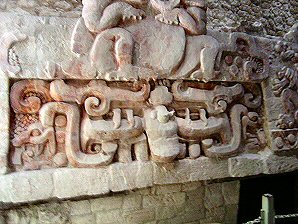 |
| Frieze Seen As Entering Structure One. Balamku Archaeological Ruins, Campeche, Rio Bec Region. Mexico. | Mystic Toad Arises From Cleft In The Earth Monsters Skull Represents Sunset King, Being Swallowed By Toad & Returning Into Earths Jaws. Frieze On The Westernmost Panel. Balamku Archaeological Ruins, Campeche, Rio Bec Region. Mexico. |
|---|---|
 |  |
| Easternmost Earth Monster Close Up. Balamku Archaeological Ruins, Campeche, Rio Bec Region. Mexico. | Most Of Freize. Balamku Archaeological Ruins, Campeche, Rio Bec Region. Mexico. |
 |  |
| Detail Left Of Decending King. Balamku Archaeological Ruins, Campeche, Rio Bec Region. Mexico. | Close View Of Small Spheres. Balamku Archaeological Ruins, Campeche, Rio Bec Region. Mexico. |
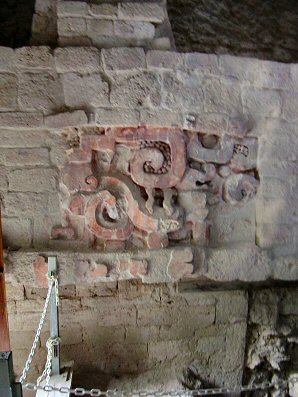 |  |
| Small Spheres Represent Preciousness And The Fertility Of The Earth. Balamku Archaeological Ruins, Campeche, Rio Bec Region. Mexico. | Easternmost Mystic Toad. Balamku Archaeological Ruins, Campeche, Rio Bec Region. Mexico. |
 | 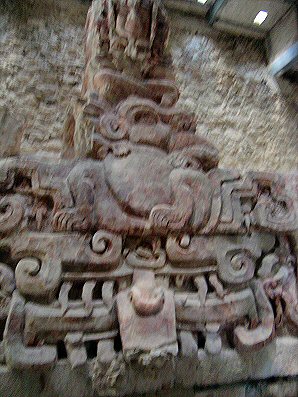 |
| Mystic Toad Arises From Cleft In The Earth Monsters Skull. Balamku Archaeological Ruins, Campeche, Rio Bec Region. Mexico. | King On East Side Of Frieze Who Represents Ascending Sun Returning From Earth Monsters Jaws Earth Monster Below King. Balamku Archaeological Ruins, Campeche, Rio Bec Region. Mexico. |
 | 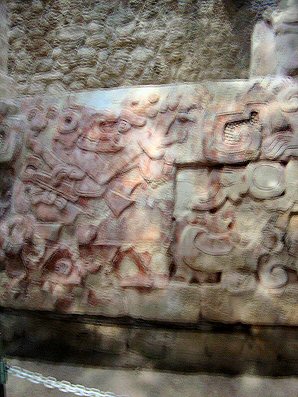 |
| King On East Side Of Frieze Who Represents Ascending Sun. Balamku Archaeological Ruins, Campeche, Rio Bec Region. Mexico. | Kneeling Jaguar Side Profile. Balamku Archaeological Ruins, Campeche, Rio Bec Region. Mexico. |
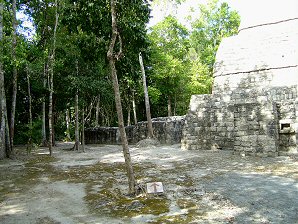 | 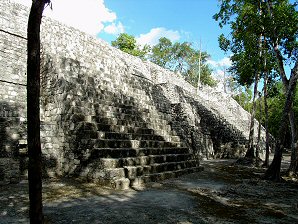 |
| "House Of The Four Kings" Inside West Side Of Structure One. Balamku Archaeological Ruins, Campeche, Rio Bec Region. Mexico. | "House Of The Four Kings" Main Part Of Structure One. Balamku Archaeological Ruins, Campeche, Rio Bec Region. Mexico. |
 | 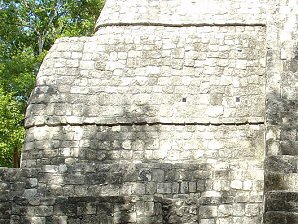 |
| Friezes Are Now Enclosed In Structure. Balamku Archaeological Ruins, Campeche, Rio Bec Region. Mexico. | Viewing Windows, There Is A Door On The Left Which A Guard Will Open If Requested. Balamku Archaeological Ruins, Campeche, Rio Bec Region. Mexico. |
 |  |
| Audrey DeLange Entered The Side Door. Balamku Archaeological Ruins, Campeche, Rio Bec Region. Mexico. | Audrey DeLange Says Viewing Windows Are Too Dark To See Anything. Balamku Archaeological Ruins, Campeche, Rio Bec Region. Mexico. |
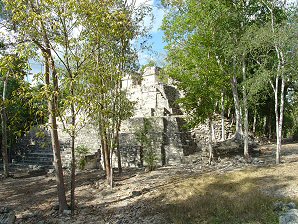 | 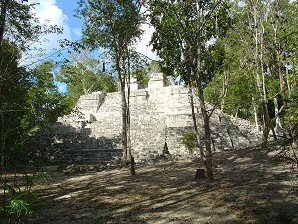 |
| Balamku Archaeological Ruins, Campeche, Rio Bec Region. Mexico. | Balamku Archaeological Ruins, Campeche, Rio Bec Region. Mexico. |
 | |
| Balamku Archaeological Ruins, Campeche, Rio Bec Region. Mexico. | Balamku Archaeological Ruins, Campeche, Rio Bec Region. Mexico. |
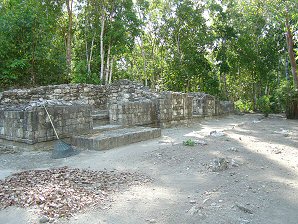 | |
| Balamku Archaeological Ruins, Campeche, Rio Bec Region. Mexico. | Balamku Archaeological Ruins, Campeche, Rio Bec Region. Mexico. |
 | 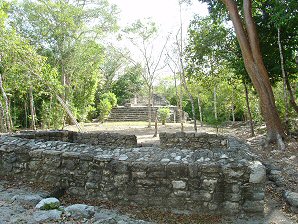 |
| Balamku Archaeological Ruins, Campeche, Rio Bec Region. Mexico. | Balamku Archaeological Ruins, Campeche, Rio Bec Region. Mexico. |
 | 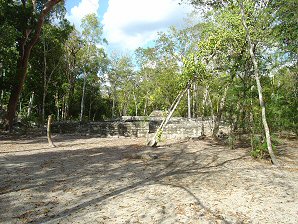 |
| Balamku Archaeological Ruins, Campeche, Rio Bec Region. Mexico. | Balamku Archaeological Ruins, Campeche, Rio Bec Region. Mexico. |
 | 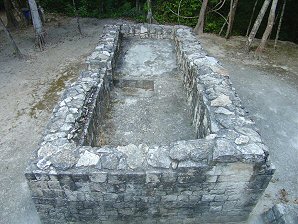 |
| Balamku Archaeological Ruins, Campeche, Rio Bec Region. Mexico. | Balamku Archaeological Ruins, Campeche, Rio Bec Region. Mexico. |
 | 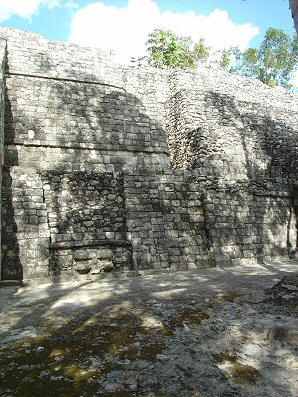 |
| Balamku Archaeological Ruins, Campeche, Rio Bec Region. Mexico. | Balamku Archaeological Ruins, Campeche, Rio Bec Region. Mexico. |
We Are Proud Of Our SafeSurf Rating!
Click On Any Of The Following Links By Amazon.Com
For Books Or Videos About Touring In Mexico. No Obligation!
Here Are Some Links To The Very Best & Most Popular Items Sold On Amazon.Com
To Learn More! Click The Links Below. No Obligation, Of Course!
Other Rio Bec Region Ruins!
Here Are Some Links To The Very Best & Most Popular Items Sold On Amazon.Com
To Learn More! Click The Links Below. No Obligation, Of Course!
Other Rio Bec Region Ruins!

